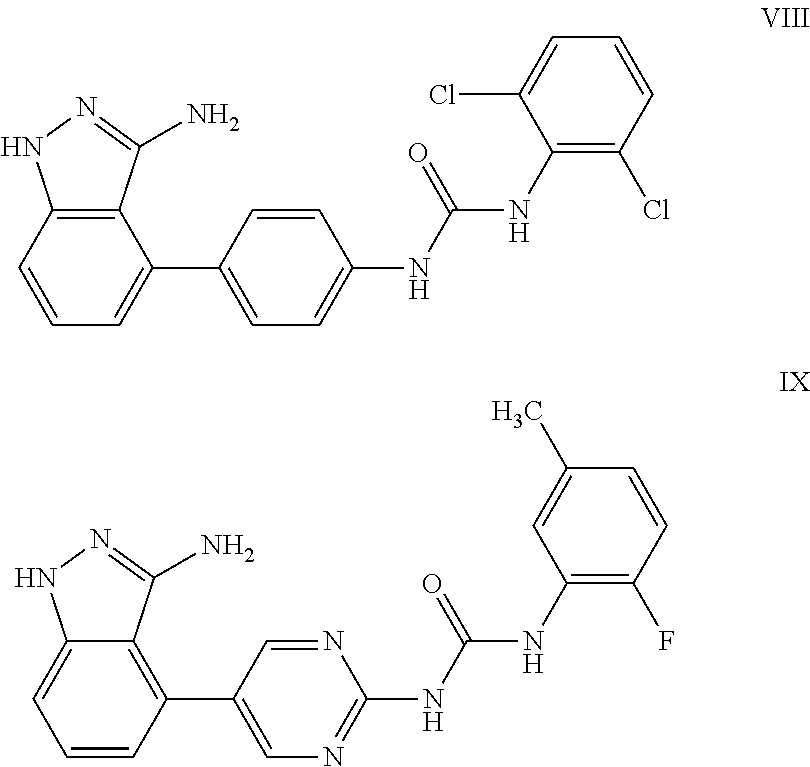Compounds for the treatment of posterior segment disorders and diseases
a technology for disorders and diseases of the posterior segment, applied in the field of compound for the treatment of posterior segment disorders and diseases, can solve the problems of scotoma and metamorphopsia, unavoidable blindness worldwide, and cnv has a tendency to leak blood and fluid,
- Summary
- Abstract
- Description
- Claims
- Application Information
AI Technical Summary
Problems solved by technology
Method used
Image
Examples
example 1
KDR Assay
[0035]METHODS. A 7-point HTRF (Homogeneous Time Resolved Fluorescence) kinase assays were performed using a Biomek 3000 Robotic Workstation in a 96-well plate format to determine IC50 values for the test compounds for KDR (VEGFR2) kinase using KinEASE-TK kit from CisBio. This is a general kit for tyrosine kinases including KDR kinase. The KDR kinase was purchased from Cell Signaling Technology. The assay is run in two steps. The phosphorylation of the biotin-tagged generic peptide substrate (2 mM) is initiated by the addition of ATP (10 mM) in the presence of KDR kinase (5 ng in 50 ml reaction mixture) in step 1 and the reaction is stopped after 30 min incubation at room temperature by the addition of a mixture containing two HTRF detection reagents and EDTA in step 2. The substrate, enzyme, and ATP dilutions were made with the buffer provided by CisBio. Compound dilutions were made either in 5% DMSO or 10:10, (DMSO:Ethanol) to prepare 4× working stock solutions. The HTRF d...
example 2
BREC Assay
[0037]METHODS. Because of their ability to potently inhibit VEGFR2, each Compound I-VII was evaluated for activity against VEGF-induced proliferation of bovine retinal endothelial cells (BRECs). Bovine retinal endothelial cells are seeded at 3000-7000 cells / well in fibronectin-coated 96 well plates in MCDB-131 growth media with 10% FBS. After 24 hours the growth media is replaced with MCDB-131 media supplemented with 1% FBS, glutamine, heparin, hydrocortisone, and antibiotics. After another 22-24 hours the cells are treated with or without 50 ng / ml VEGF media and the test compounds in the 1% FBS media. After 30 hours BrdU is then added for the final 16 hours of the incubation. All cells are then fixed and assayed with a colorimetric BrdU ELISA kit.
[0038]RESULTS. All Compounds (I-VII) demonstrated potent and efficacious inhibition of VEGF-induced proliferation, where all seven Compounds provided an EC5050<0.5 nM (Table 2). Moreover, all seven Compounds exhibited a relative ...
example 3
Intravitreal Delivery of Compounds I-VII, Inhibits VEGF-Induced Retinal Vascular Permeability in the Rat
[0039]METHODS: Adult Sprague-Dawley rats were anesthetized with intramuscular ketamine / xylazine and their pupils dilated with topical cycloplegics. Rats were randomly assigned to intravitreal injection groups of 0% 0.3%, 1.0%, and 3.0% formulations of Compounds I-VII and a positive control. Ten μl of each compound was intravitreally injected in each treatment eye (n=5˜6 animals per group). Three days following first intravitreal injection, all animals received an intravitreal injection of 10 μl 500 ng hr VEGF in both eyes. Twenty-four hours post-injection of VEGF, intravenous infusion of 3% Evans blue dye was performed in all animals, where 50 mg / kg of Evans blue dye was injected via the lateral tail vein during general anesthesia. After the dye had circulated for 90 minutes, the rats were euthanized. The rats were then systemically perfused with balanced salt solution, and then b...
PUM
| Property | Measurement | Unit |
|---|---|---|
| Fraction | aaaaa | aaaaa |
| Fraction | aaaaa | aaaaa |
| Fraction | aaaaa | aaaaa |
Abstract
Description
Claims
Application Information
 Login to View More
Login to View More - R&D
- Intellectual Property
- Life Sciences
- Materials
- Tech Scout
- Unparalleled Data Quality
- Higher Quality Content
- 60% Fewer Hallucinations
Browse by: Latest US Patents, China's latest patents, Technical Efficacy Thesaurus, Application Domain, Technology Topic, Popular Technical Reports.
© 2025 PatSnap. All rights reserved.Legal|Privacy policy|Modern Slavery Act Transparency Statement|Sitemap|About US| Contact US: help@patsnap.com


